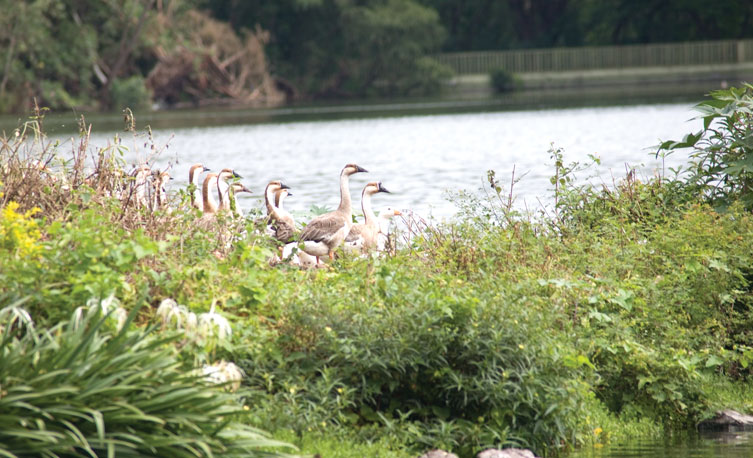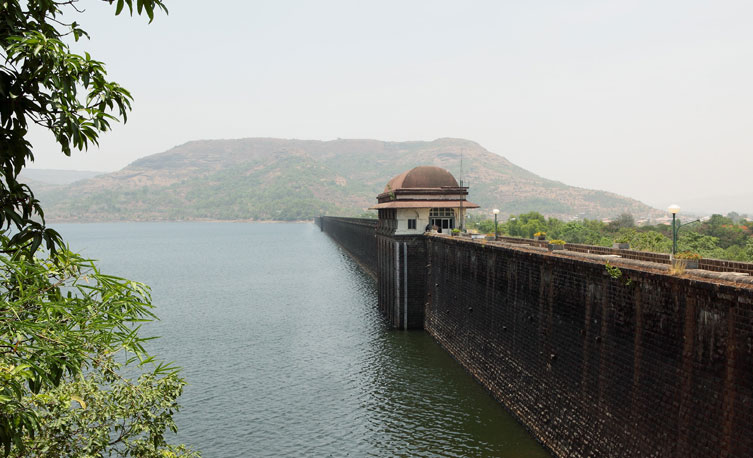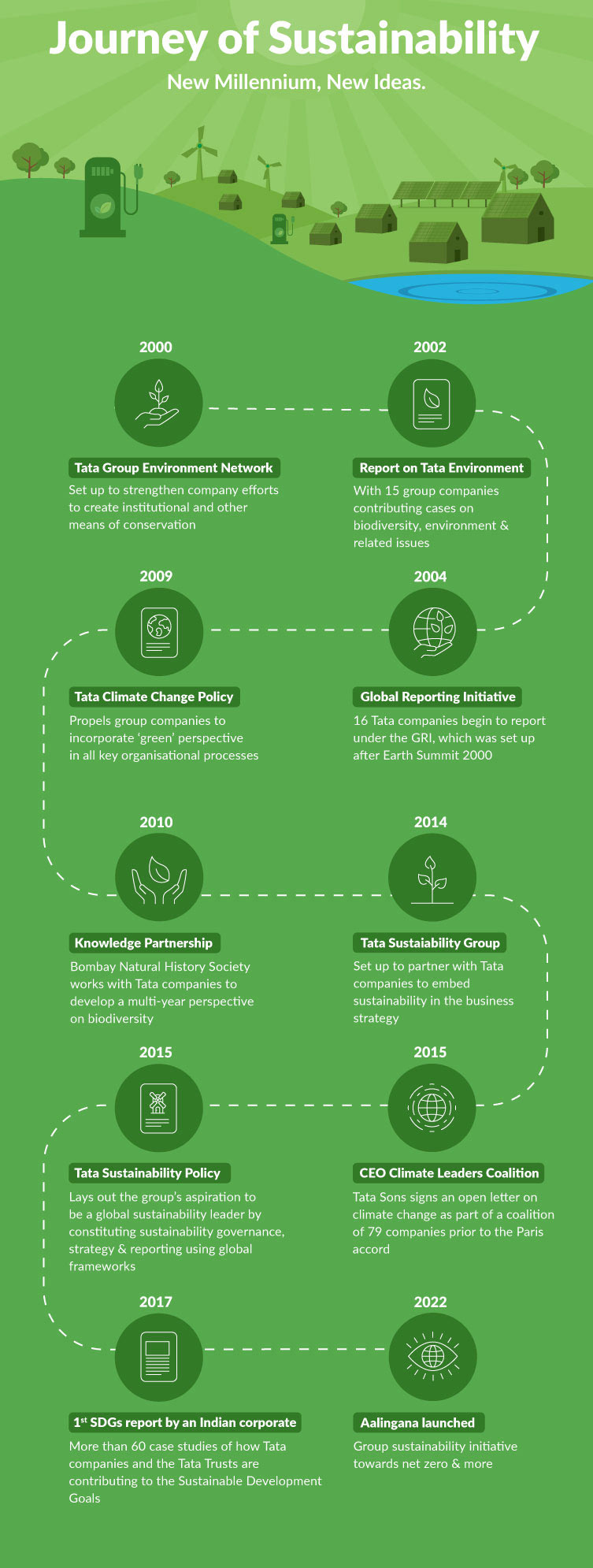December 2022 | 1767 words | 7-minute read
In 2022, the Tata group ranked No 1 in Asia Pacific on the Globe Scan SustainAbility Leaders Survey, the largest and longest-running survey of its kind. The group also featured in the global top 15 for the second time in three years — the only Asian company to do so.
The recognition came close on the heels of the launch of Aalingana — driven by the vision of N Chandrasekaran, chairman, Tata Sons, to define a group-wide approach to environmental sustainability that will position the Tata group among global leaders.
“Driving momentum towards a sustainable future is a big priority… I think sustainability is the biggest challenge for humankind for the next decades to come, and we definitely need to address this,” believes Mr Chandrasekaran.
Speaking at a recent event, he said, “I am very glad about the bold commitment the government made at COP26 about going net zero by 2070. The targets for 2030 are also very encouraging. And we have a lot to do — in terms of electric vehicles, looking at hydrogen for commercial vehicles, greening our tough sectors like steel, cement, renewable power both for the utility scale and the consumer.”
"Sustainability is the biggest challenge for humankind for the next decades to come, and we definitely need to address this." - N Chandrasekaran, Chairman, Tata Sons
Aalingana outlines the Tata aspiration of net zero by 2045 and the group’s vision of protecting the world and building the future through the technologies of tomorrow. It also stays true to the social and environmental responsibility embedded in the group by the Founder himself.
Sustainable Start
More than a century before the conversation around climate change became mainstream, Jamsetji Tata knew that sustainability was key to business. His vision of sustainability was documented in his letters related to the starting of new industries.

When he applied for prospecting licenses in 1901 to explore raw materials for the steel industry that he wished to set up, he sought assurance of the “Forest Department undertaking to plant afresh all such trees as may be cut down for the purpose”. “Or, if Government desire it I am willing to undertake the cutting down and replanting of trees on Government allotting to me certain areas of forests,” he had added.
In a letter to his son Sir Dorabji Tata in 1902, outlining his blueprint of a township for the workers at the steel plant he was dreaming of, he had said, "Be sure to lay wide streets planted with shady trees, every other of a quick-growing variety. Be sure that there is plenty of space for lawns and gardens."
Jamsetji was also one of the early proponents of using clean energy to power industry. As early as 1875 he contemplated harnessing the power of water to generate clean, renewable energy that would be available to “run the tramways of Bombay, to supply as much electric lighting as may be required in Bombay, and to have a balance over for the supply of power in a few cotton mills, and sufficient for small local industries.”
He did not live to see the launching of the hydroelectric project, but while switching on Tata Power electricity to the first mill in 1915, Sir Dorabji had said, “To my father, the hydroelectric project was not merely a dividend-earning scheme; it was a means to an end — the development of the manufacturing power of Bombay… the great sums of money needed were forthcoming mainly because those who commanded them believed that the scheme would assuredly play an important part in the industrial renaissance of India, which is of paramount importance to the whole future of the country.”
Building Trucks and Lakes
The Founder’s vision has served as the north star of the generations that followed. JRD Tata’s famous attention to detail extended even to the green cover at Tata companies and institutes.
He supported the conversion of a scrubby barren area into a wetland habitat, covering 245 acres, inside the Tata Motors plant in an industrial belt near Pune. The habitat was planned in the 1960s, at the same time as the manufacturing facility. A dam was constructed to conserve rainwater; the resulting lake now holds about 60 million gallons of water, which helps sustain the green cover — a marshy area with reed beds, open scrub land and an area with dense tree cover where around 150,000 trees have been planted. The wetland attracts more than 150 species of birds and around 60 types of butterflies.
“We did not have to create a lake to produce a truck. But we did,” JRD famously said.
JRD also recognised the impact of population growth on the environment, and candidly drew attention to it. “This has led to an increase in the demand on Earth’s resources and in countries like India, this poses environmental havoc,” he once said. “Due to over population, some of the plainly visible issues are high rate of deforestation, soil erosion, silted waterways, recurring floods everywhere.”

And in 1992, just a year before his death, he outlined the need for greater focus on sustainability within the Tata group in the years to come. “I believe that the social responsibility of our industrial enterprises should now extend, even beyond serving people, to the environment,” he wrote. “This need is now fairly well recognised but there is still considerable scope for most industrial ventures to extend their support not only to human beings but also to the land, to the forests, to the waters and to the creatures that inhabit them.”
Encoding Sustainability
Over the 1990s and 2000s, under the chairmanship of Ratan N Tata, now Chairman emeritus of Tata Sons, social responsibility towards the environment were encoded in the Tata Business Excellence Model and the Tata Code of Conduct (TCOC).
The TCOC mandates that Tata companies will “comply, in the conduct of its business affairs, with all regulations regarding the preservation of the environment of the territory it operates in” and “be committed to prevent the wasteful use of natural resources and minimise any hazardous impact of the development, production, use and disposal of any of its products and services on the ecological environment”.
The Tata Code of Conduct mandates that Tata companies will “comply, in the conduct of its business affairs, with all regulations regarding the preservation of the environment of the territory it operates in.”
Siddharth Sharma, Group Chief Sustainability Officer, Tata Sons, says, “Mr Ratan Tata was one of the Indian business leaders invited to be a part of the deliberations leading up to the 1992 Rio Conference. The Tatas subsequently contributed to the creation of the environment division at the Confederation of Indian Industries (CII), with the charter to create awareness and support industry efforts on environment assessment, planning and management. Mr Tata felt that since the group had a large environmental footprint, being present in emission intensive sectors, it was time to start thinking about how the carbon footprint could be reduced. A high-level steering committee on climate change was created, which ultimately led to the Tata Climate Change Policy being enunciated and signed by Mr Tata in 2009.”
The policy committed group companies to combat climate change by being knowledgeable and responsible and by adopting environment-friendly technologies, innovations and business practices while pursuing their growth aspirations.
In 2014, the Tata Sustainability Group (TSG) was formed, bringing together environmental and social initiatives under one umbrella. TSG serves as the group’s nodal resource on sustainability, works closely with companies to embed sustainability in their business strategies and helps them demonstrate responsibility towards society and the environment — all with a view to making them future ready and resilient.
The Aalingana Initiative
Standing firm on this foundation, the Tata group is now poised to embrace the future of the planet with Aalingana. It has been launched with sustainability commitments from seven companies — Tata Steel, Tata Power, Tata Motors, Jaguar Land Rover, Tata Chemicals, Tata Consultancy Services and Tata Consumer Products. In FY20, these companies made up 99.5% of the group’s Scope 1 and Scope 2 emissions, 94% of freshwater use and 99.4% of solid waste.
Collaboratively developed with group companies, Aalingana is focused on three interconnected pillars: driving the decarbonisation of our businesses and value chain; applying a systemic, circular economy approach to reduce resource-use and waste; and preserving and restoring the natural environment. It commits to embedding sustainability right into their business strategy.
“It goes without saying that nature and climate are the most pressing issues of our time,” says Roopa Purushothaman, Chief Economist and Head of Policy Advocacy, Tata Sons. “The Aalingana vision is for the Tata group to protect the world and build the future through the technologies of tomorrow. This reflects our firm belief that sustainability needs to be at the core of what we do going forward, and that the group will strive to be a leader in developing and scaling the new technologies that are needed to drive a green transition.”
"With Aalingana, we are building a ‘One Tata’ platform to maximise the impact we can have on markets, communities and the value-chain." - Roopa Purushothaman, Chief Economist and Head of Policy Advocacy, Tata Sons
This green transition, she believes, is the next big opportunity, akin to what digital has been in recent decades: “Sectors like automotive, financial services and energy are being fundamentally transformed. At the same time, there are risks from not embracing change fast enough. Fundamental business sense, a long-term focus, government incentives, and customer as well as employee demand for change are all enabling a structural shift.”
Sustainability through Synergy
Aalingana leverages the power of group synergies to help companies achieve sustainability targets. Ms Purushothaman puts the importance of this approach in perspective.
“With Aalingana, we are building a ‘One Tata’ platform to maximise the impact we can have on markets, communities and the value-chain,” she says. “This group-wide synergized approach to sustainability is important in three key ways. First, a coordinated approach can not only accelerate awareness and action across the group but also create a meaningful growth opportunity for companies. Second, given our breadth of industries and geographies we have the opportunity to show real leadership, both in India and globally. And finally, the strong alignment with the group’s ethos of community responsibility compels us to act.”
"With the Aalingana metrics, the Chairman has not only aligned us to India’s vision of sustainability and climate change but also put us at the vanguard of the massive global effort aimed at combating climate change and bringing about more environmentally responsible growth." - Siddharth Sharma, Group Chief Sustainability Officer, Tata Sons

A testament to the group’s progress on sustainability is its GlobeScan-SustainAbility Leaders Survey 2022 ranking as No 1 in Asia Pacific. “The recognition,” says Mr Sharma, “comes at an opportune moment, when the Tata group has announced bold targets on environmental sustainability aspects of climate change, circular economy and nature and biodiversity. With the Aalingana metrics, the Chairman has not only aligned us to India’s vision of sustainability and climate change but also put us at the vanguard of the massive global effort aimed at combating climate change and bringing about more environmentally responsible growth.”

Project Aalingana at a Glance
Driving Net Zero
- 2030 25% reduction in absolute carbon emissions*
*From 2020 baseline (Scope 1 & 2); Tata Steel India to reduce emissions intensity by 28-30% from 2020 baseline - 2045 Net zero emissions across the group*
*Scope 1 & 2 across companies; scope 3 for JLR, TML, TCS, TCPL
Pioneering Circular Economies
- 2025 More than double the content of renewable or recycled resources in products*
*Over 2020 baseline - 2030 Replenish freshwater & zero waste to landfill*
*Freshwater target for India operations only - 2040 Replenish more freshwater than consumed
Preserving nature & biodiversity
- 2024 Action plans for net positive impact
- 2025 Invest in Nature-Based Solutions projects in India
- 2030 Group is an NBS leader and has supported NBS market in India
Timeline: New Millennium, New Ideas
- 2000: Tata Group Environment Network
Set up to strengthen company efforts to create institutional and other means of conservation - 2002: Report on Tata Environment
With 15 group companies contributing cases on biodiversity, environment and related issues - 2004: Global Reporting Initiative
16 Tata companies begin to report under the GRI, which was set up after Earth Summit 2000 - 2009: Tata Climate Change Policy
Propels group companies to set industry benchmarks in carbon footprint reduction, participate in climate change advocacy, incorporate ‘green’ perspective in key organisational processes - 2010: Knowledge partnership
Bombay Natural History Society works with Tata companies to develop a multi-year perspective on biodiversity - 2014: Tata Sustainability Group
Set up to partner with Tata companies to embed sustainability in the business strategy - 2015: CEO Climate Leaders Coalition
Tata Sons signs an open letter on climate change as part of a coalition of 79 companies prior to the Paris accord - 2015: Tata Sustainability Policy
Lays out the group’s aspiration to be a global sustainability leader by constituting sustainability governance, strategy and reporting using global frameworks - 2017: First SDGs report by an Indian corporate
More than 60 case studies of how Tata companies and the Tata Trusts are contributing to the Sustainable Development Goals - 2022: Aalingana launched
Group sustainability initiative towards net zero & more
- Monali Sarkar



